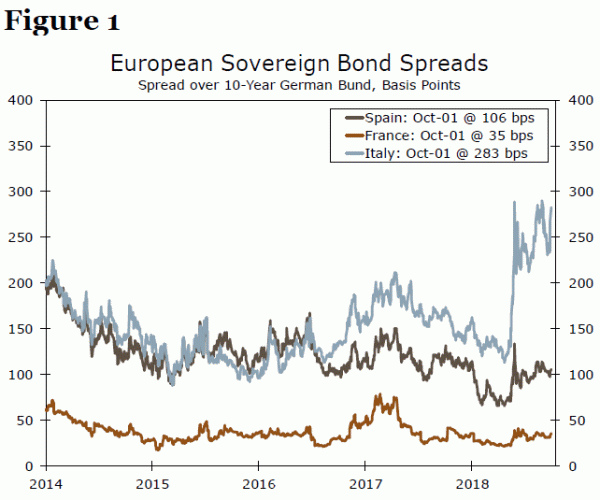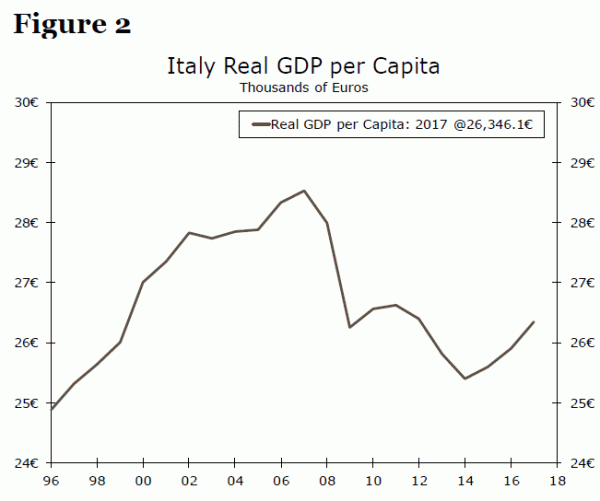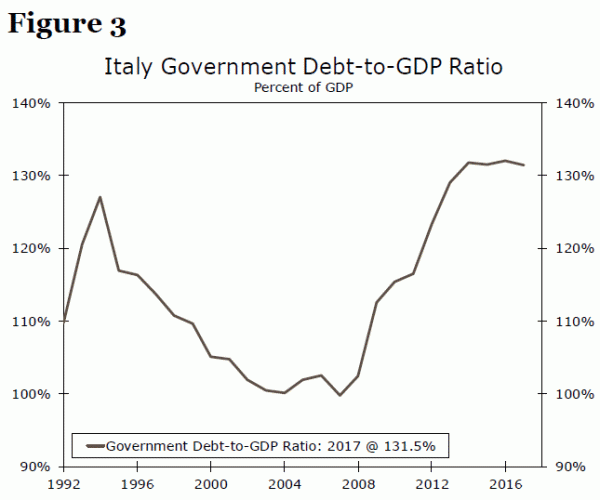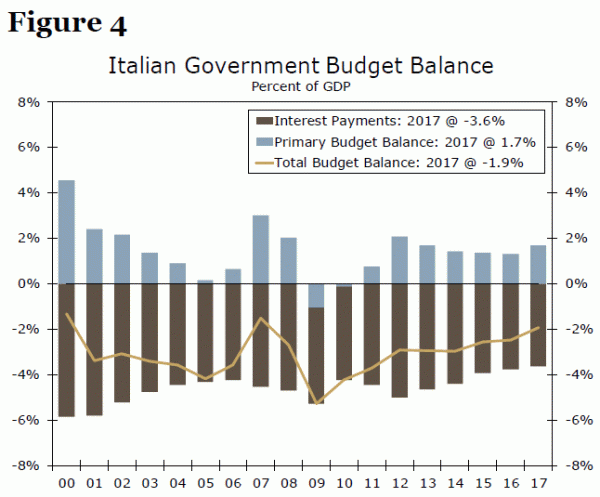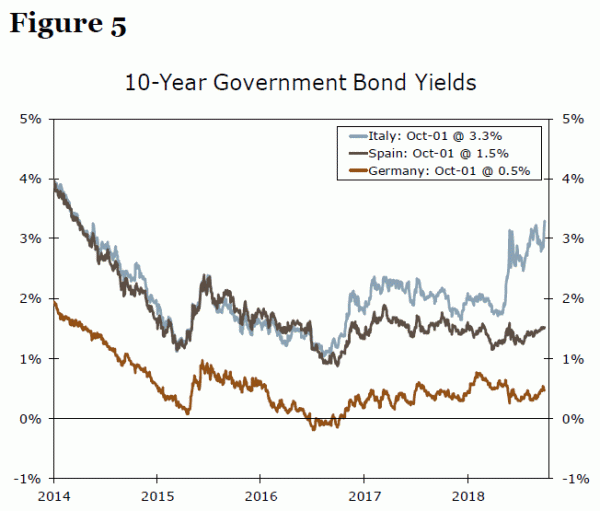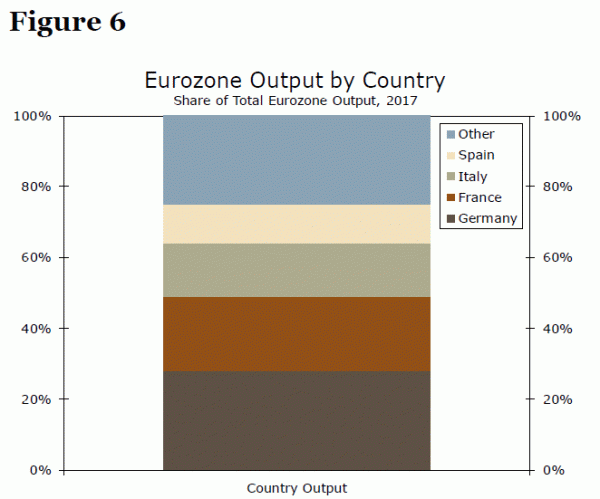Executive Summary
Against a backdrop of high sovereign debt levels and slow growth, the Italian elections held earlier this year eventually produced a coalition government between two parties generally perceived to have a populist tilt: the Five Star Movement (5SM) and the Lega (the League). Both parties have expressed some Euroscepticism and a strong desire to enact expansionary fiscal policies, though the specific policy proposals originate from opposite ends of the political spectrum. The first big step in the budget process occurred on September 27, when Italian policymakers set their top-line budget figures. The key number was a deficit target of 2.4% of GDP for 2019, above the 0.8% target set by the previous government back in April. The 2.4% target still technically complies with the 3% limit imposed by the European Union (EU), but given Italy’s large stock of debt EU policymakers may still be wary. In our view, Italy’s proposed deficit target of 2.4% in 2019 is probably just small enough to avoid a major showdown with Brussels. If that deficit target is realized, nominal GDP would have to grow at roughly a 3% pace next year to keep the debt-to-GDP ratio steady, a key factor given that Italy is already in clear violation of the EU’s limit of a 60% debtto- GDP ratio. While 3% is a bit faster than the current 2.7% pace, it is at least a feasible outcome.
However, the Italian government will need to go from high-level projections to concrete policy proposals in the coming weeks. Should the Italian coalition have trouble fitting its outsized policy wishes into that deficit target, the two most likely outcomes in our view would be an increase in the target or a collapse of the government coalition. A collapse of the current coalition would probably bring about a rally in Italian bonds, as the current champions of Euroscepticism and fiscal profligacy lose their grip on power. An increase in the deficit target to 3% or more, however, would likely fuel a further sell-off in Italian debt, in our view, as a breach of the 3% target and/or a rising debt-to-ratio is far more likely to prompt a showdown between Brussels and Rome.
How Did Italy Get Here?
To understand the challenges facing policymakers in Italy, it is helpful to understand how we got here in the first place. Italy’s fiscal woes go back several decades; the general government debt-to- GDP ratio has been above 100% for decades (Figure 3). As a point of comparison, the corresponding metric in the United States is 108% today and was just 65% back in 2007. However, unlike some other countries whose fiscal situation has deteriorated in recent years amid new spending/tax cuts, Italy has run a primary budget surplus (revenues less noninterest spending) for years (Figure 4). Why then has the Italian debt situation not seen more improvement? For one, the sizable interest payments on the large stock of Italian debt have been a major driver. Interest spending amounted to 3.6% of GDP in 2017 and was as high as 5% as recently as 2012. Thus despite fairly prudent fiscal policy over the past few years, interest costs have been a big factor keeping Italian policymakers from driving down the debt-to-GDP ratio very quickly.
Vexing policymakers further has been the remarkably slow growth environment in Italy. Real GDP per capita in Italy is lower today than it was in 2000 (see chart on front page). While nominal GDP growth has been a bit stronger of late (up 2.7% year over year through Q2-2018, the fastest pace in seven years), it has been not been strong enough to provide a significant bump to the denominator portion of the debt-to-GDP ratio. Without faster nominal GDP growth, the primary budget surplus would need to be even larger than it already is to reduce the debt-to-GDP ratio meaningfully. Public investment, an area where high levels of spending today might translate into faster long-run growth down the road, has been far from robust. Government investment as a percent of GDP was just 2.3% in 2015, down from 2007 levels and nearly a percentage point below the OECD average.1
Against this backdrop of high debt levels and slow growth, the Italian elections held earlier this year eventually produced a coalition government between two parties generally perceived to have a populist tilt: the 5SM and the League. Both parties have expressed some Euroscepticism and a strong desire to enact expansionary fiscal policies, though the specific policy proposals originate from opposite ends of the political spectrum. The more ‘left-wing’ 5SM has advocated for more public investment, a lower retirement age and some form of universal basic income for low-income individuals, while the more ‘right-wing’ League has pushed for tax cuts primarily via a 15% acrossthe- board flat tax. Details on these policies have been somewhat vague, and as a result estimates of how costly these policies would be have varied, but it appears likely that full implementation of each party’s platform would push the budget deficit up by multiple percentage points of GDP.
What Is Stopping Italy from Going Full Steam Ahead on Fiscal Policy?
As the United States has proved recently, a challenging long-run fiscal outlook is not necessarily an insurmountable obstacle to passing a major fiscal stimulus. Yet Italy faces a few additional hurdles that make passing a budget-busting bill into law difficult. First, as a member of the EU, Italy is subject to the Stability and Growth Pact, an agreement among those countries that, among other things, limits each country’s government budget deficit to 3% of GDP.2 Though the 3% limit is really more of a “soft” rather than “hard” limit in practical terms, an egregious breach of the target would likely subject Italy to a process known as the Excessive Deficit Procedure (EDP), which in short involves the European Commission engaging with the member state in an effort to reign in the deficit. A deep dive into this procedure is beyond the scope of this report, but the key takeaway is that under this scenario EU policymakers would likely attempt to bring profligate Italian policymakers to heel in a long, drawn out process that could theoretically involve financial penalties on the country. Whether or not the EU would succeed in altering the path of Italian fiscal policy is an open question, but even just the headline risk over such a showdown could push up Italian bond yields, squeezing Italy further as interest costs rise.
Second, as discussed earlier, Italy’s high stock of debt makes it particularly sensitive to an increase in interest rates. As recently as 2012, Italy was spending 5% of GDP on interest payments. This has fallen to 3.6% today as interest rates on Italian sovereign bonds have fallen. With yields on the 10-year benchmark Italian sovereign bond up about 150 basis points since May, Italy may begin to see some budget deficit pressure even in the absence of fiscal stimulus.3 Third, the old saying that “politics makes for strange bedfellows” has been proved once again by the current Italian coalition government. Since the coalition was formed in May, there have been at times signs of disagreement between the two major ruling parties over how to prioritize the cornucopia of fiscal easing measures. The current government is the 66th Italy has had since World War II, and this is an unusual coalition even by Italian standards, so it is no guarantee that the current government will be able to withstand the challenges of passing major budget changes.
What Are the Implications of the Budget Process?
Yields on Italian bonds jumped in May after the coalition government was formed, with the 10-year Italian sovereign bond yield reaching 3.24% in late August, the highest level since 2013. Spreads over the German bund also jumped, but so far the contagion to yields in other core European countries has been fairly limited (see chart on front page). In recent weeks, Italian bonds rallied as markets awaited the release of the Economic and Financial Document (DEF), which proposes top-line budget figures like the deficit target. The release finally came late on September 27 in what was the first key step in what will likely be a protracted process over the next few months. In that document, the government set a deficit target of 2.4% of GDP for 2019, above the 0.8% target set by the previous government back in April. The figure of 2.4% of GDP still complies with the 3% limit imposed by the EU, but given Italy’s large stock of debt EU policymakers may still be wary. Italian sovereign bonds once again sold off on the news as the deficit target was a bit larger than initial reports had indicated (Figure 5). It appears that at the eleventh hour members of the 5SM/League demanded a bit more fiscal stimulus than had been originally baked into the projections.
In terms of next steps, Italy must submit a draft budget to the European Commission (EC), the executive arm of the EU by October 15. The draft budget will provide more specific policy details than the more high-level, top-line targets released in the DEF. If the EC takes issue with Italy’s proposed budget, including as it relates to the EU budget rules, it has until November 30 to ask Italy’s government for a revision. Though the EC can attempt to alter the path of Italian fiscal policy, it is important to remember that Italy remains a sovereign nation with ultimate control over its budget.
What does this mean for the outlook for bond yields in Italy and in the rest of the world? There are two primary avenues through which yields will respond to the Italian budget: a possible “reflation” trade and concerns over the future of the Eurozone. To the first point, the traditional response to a deficit-financed fiscal stimulus should be higher rates across the curve, all else equal, as bond issuance ramps up, there is some near-term bump to economic growth/inflation and central banks respond to these stronger macroeconomic conditions. This has been most clearly seen in the United States over the past year or so. Might fiscal stimulus and thus faster growth/inflation in Italy spur a broader pick-up in the Eurozone and a more hawkish European Central Bank (ECB), thus causing the increase in Italian bond yields to spread to the rest of Europe? While this is a possibility, we are skeptical an Italian fiscal stimulus would be enough to spur a reaction similar to what has occurred in the United States. Italy represents just 15% of economic output in the Eurozone (Figure 6). In a sense, a fiscal stimulus in Italy would be similar to a fiscal stimulus in a major U.S. state; probably not enough to meaningfully move the needle much for the ECB in the near-term.
Perhaps more fundamentally, yields on Italian sovereign bonds have also risen as investors price in a risk premium that a fiscal showdown between Italy and the rest of Europe could put the future of the Eurozone at risk. Italy is among the 10 largest economies in the world, and its government debt outstanding totals €2.3 trillion, making its sovereign debt market roughly seven times larger than Greece’s. In our view, Italy’s proposed deficit target of 2.4% in 2019 is probably just small enough to avoid a major showdown with Brussels. If that deficit target is realized, nominal GDP would need to grow at roughly a 3% pace next year to keep the debt-to-GDP ratio steady, a key factor given that Italy is already in clear violation of the EU’s limit of a 60% debt-to-GDP ratio. While 3% is a bit faster than the current 2.7% pace, it is at least a feasible outcome.
That said, the Italian government will need to go from high-level projections to specific policy proposals in the coming weeks. Triangulating the course that satisfies the starkly different partners in the coalition will not be an easy task, and we view the long-term stability of the current coalition as a large question mark. Crafting a budget when the deficit target is increasing is always easier than meeting austerity goals, however, and our base case is that Italy will in the end more or less stick to the proposed 2.4% target. To use the United States as an example, the recent tax reform bill had its moments of peril, and Republican policymakers in the United States had to abandon some initial proposals for budget reasons, such as making the individual tax cuts permanent. From a political standpoint, a smaller-than-promised stimulus is still often a better alternative than no stimulus at all. Under this scenario, Italian bond yields might rise a bit further as markets consider what this inflection point means for the longer-run financial health of the country, but most of the damage has likely already occurred, so long as a full-blown showdown with the EU is avoided.
However, should the Italian coalition run into trouble in the coming weeks as it tries to fit its outsized policy wishes into the deficit target, the two most likely outcomes in our view would be an increase in the target or a collapse of the government coalition. A collapse of the current coalition would probably bring about a rally in Italian bonds, all else equal, as the current champions of Euroscepticism and fiscal profligacy lose their grip on power. An increase in the deficit target to 3% or more, however, would likely fuel a further sell-off in Italian debt, in our view, as a breach of the 3% target and/or a rising debt-to-GDP ratio is far more likely to prompt a more pronounced showdown between Brussels and Rome.
Taking a longer-run view, the challenges of stagnant living standards and high debt levels that have sparked the current political situation are unlikely to abate anytime soon. Even if Italian policymakers thread the needle on fulfilling their campaign promises while avoiding sanctions from Brussels, rising rates in Europe in the years ahead will likely put additional pressure on the sustainability of Italian debt, making future policy choices even more daunting. Furthermore, unless real GDP per capita rises in a meaningful and sustained way, the populist rumblings in the Italian political system are unlikely to completely fade away. Thus, we believe Italian budget drama is likely to periodically come into focus for financial markets for years to come.
1 OECD. (2017). “Government investment as percentage of GDP, 2007, 2009, 2015 and 2016”, in Public Finance and Economics, OECD Publishing, Paris, https://doi.org/10.1787/gov_glance-2017-graph36-en.
2 For more detail on the Stability and Growth Pact and how the European Commission deals with breaches of the deficit/debt targets, see: https://ec.europa.eu/info/business-economy-euro/economic-and-fiscal-policy-coordination/eu-economic-governance-monitoring-prevention-correction/stability-and-growth-pact_en
3 Bryson, H. J., Quinlan, T. & Nelson, E. (March 2016). “How Sustainable Is European Sovereign Debt?” Wells Fargo Economics. Available upon request.




